Strength training is essential for any runner looking to stay strong, healthy and less injury prone.
There are many strength exercises for runners that can help you improve your running performance.
From bodyweight exercises to using free weights, there are exercises to suit every type of runner and fitness level.
If you’re new to strength training, then in this guide I’ll share some simple strength exercises for runners that anyone can master.
These exercises are great because you don’t need any specialist equipment to do them and they can be done easily from the comfort of your own home.
Wherever you’re at in your running journey, now is the time to start adding strength training to your training plan.
As I explain in this guide, strength training really has the potential to level up your running.
If you find you regularly experience injury or struggle to keep proper form and posture on a run, then you could benefit from adding strength training exercises into your running routine.
But where exactly do you start when it comes to strength training?
In this guide we’ll look at:
- What is strength training?
- What are the benefits of strength training?
- What type of strength exercises should runners do?
- How often should runners strength train?
- How heavy should runners lift?
- Will I become too bulky by strength training?
- 6 simple strength exercises for runners
Ready?
Let’s get started!
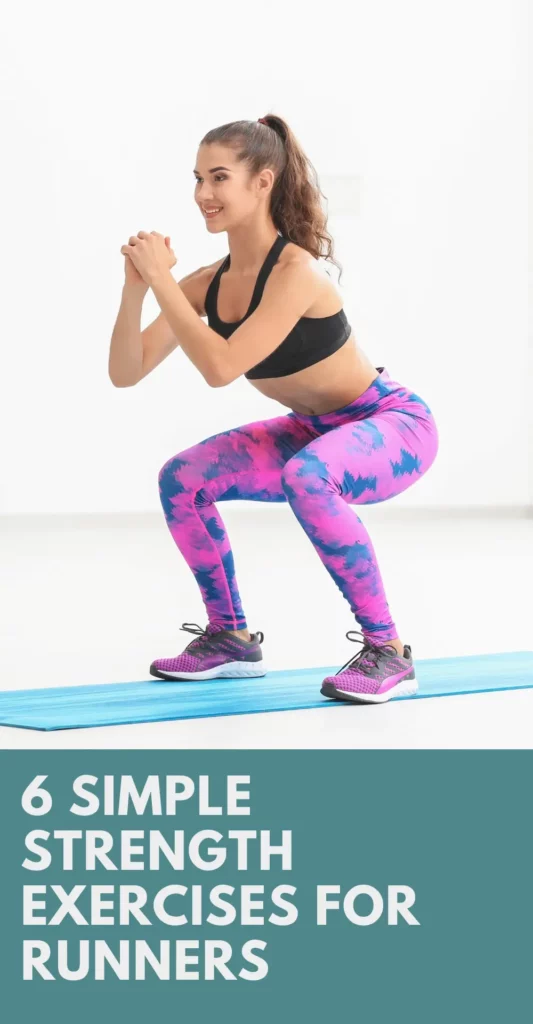
What is strength training?
Strength training is essentially any type of exercise that uses resistance to build the strength, anaerobic endurance and size of muscles.
Resistance can be in the form of your own bodyweight or free weights like dumbbells or kettlebells.
In some cases resistance bands are also used.
The main aim of strength training is to increase strength and power, so the focus should be on lifting weights.
It should not involve exercise that elevates your heart rate (e.g. cardio).
You get enough cardio by running every week.
So whether you do a strength workout at home, at the gym, or outdoors after a run, keep the focus of the workout on lifting weights.
Related: 30 day strength training plan for runners
What are the benefits of strength training for runners?
Various articles and studies have proven the link between strength training and running and how it can help you become a stronger runner.
A 2019 study from the British Journal of Sports Medicine summarises the benefits of strength training for runners.
It concluded that the following areas benefit from strength training:
- Improved running economy
- Faster time trial performance
- Faster maximal sprint speed
Strength training also has the potential to improve your running performance in multiple ways.
It helps to:
- Build stronger muscles and connective tissues
- Improve running performance
- Prevent common running injuries
- Improve your running form and economy
- Increase running speed
- Build your resilience
- Boost your metabolism
- Boost your self-esteem and confidence
Related: Strength training exercises for runners: The complete guide
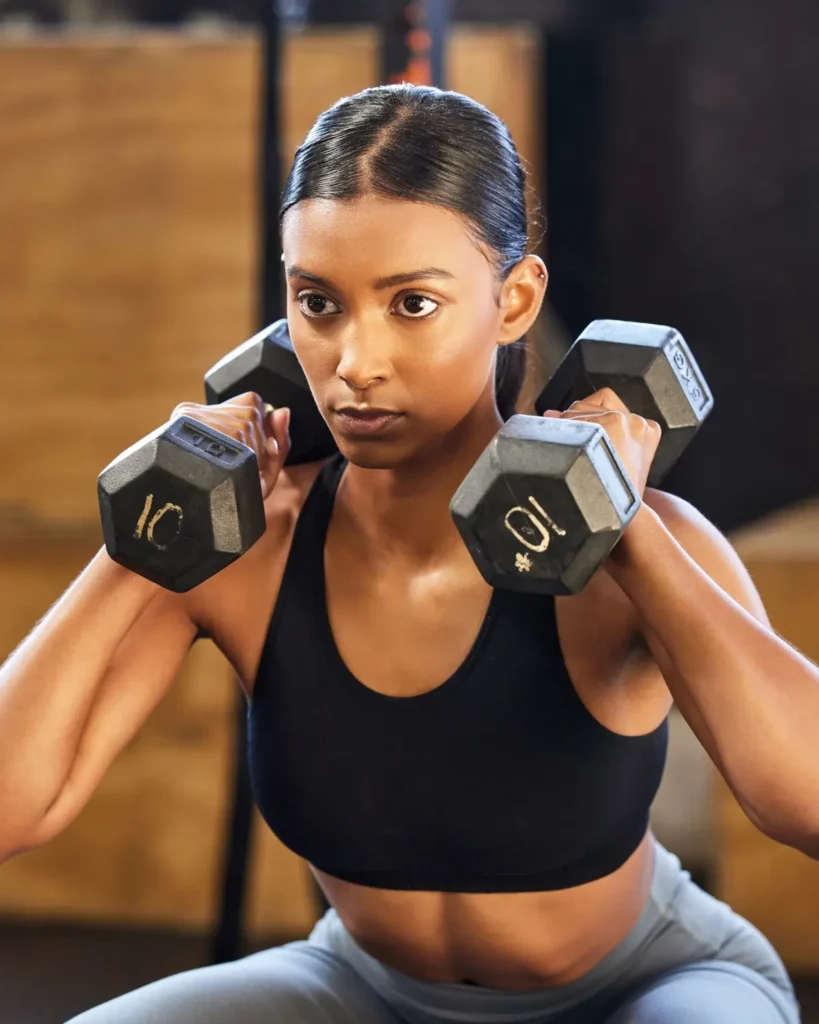
What type of strength exercises should runners do?
The best strength exercises for runners are those that focus on:
- Full body movements (also known as compound exercises)
- Unilateral movements (movements that use a single leg or arm)
- Core strength
Full body movements
You use a range of muscle groups during running.
Muscles in your legs, core, upper body and arms all work together when you run, so it’s important you incorporate ‘full body’ / compound movements in your training routine.
Unilateral movements
Running is considered a unilateral form of movement.
This essentially means your legs move independently of one another, supporting your body.
Therefore, it’s important you focus on strength training exercises that target a single leg or arm.
Core strength
Your core is extremely important when running because it helps you hold a strong and stable position for longer.
If you find yourself slumping towards the end of a run, this is a sign that need to work on your core.
Related: 30 day workout challenge for runners
How often should runners strength train?
To really benefit from strength training, you need to be doing at least two strength training workouts each week.
If you’re worried about fitting these workouts into your schedule, research suggests that even a 20-minute strength workout has the potential to improve your strength.
Related: The ultimate 14 day strength training plan for runners
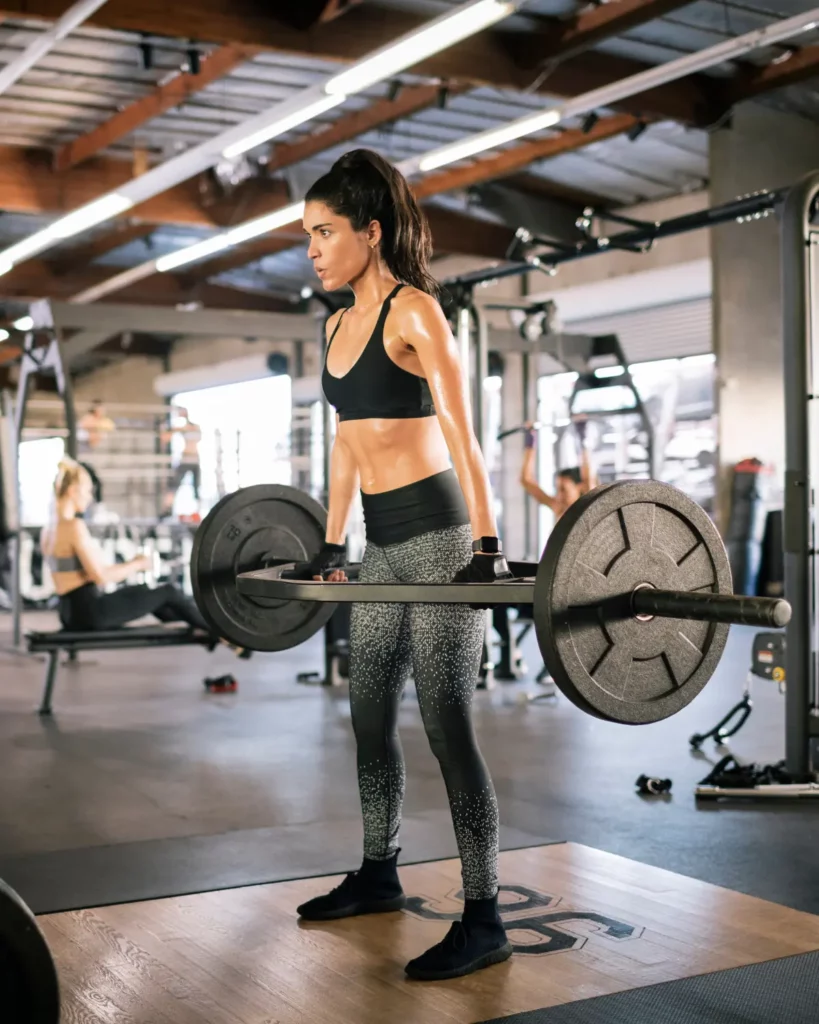
How heavy should runners lift?
The resistance you use in a strength workout needs to be relatively heavy.
The easiest way to identify the best weight for you is to pick a weight where you can only manage 4 to 6 repetitions.
If you’re able to lift a weight easily for 10 to 20 repetitions, then it’s too light.
Whereas if you’re barely able to lift the weight off the ground, it’s too heavy.
The key is to find the right level of resistance for you.
There is no one size fits all weight – every runner will be different depending on age, gender, fitness levels etc.
Related: 7 of the best running workouts to build endurance, strength and speed
Will I become too bulky by strength training?
Many runners are put off by strength training because they think it will make them too bulky, when this is simply not the case.
You’d need to do A LOT of strength training each week, without any cardio, in order to match the gains of an Olympic weightlifter.
Related: Weightlifting for runners: 5 reasons to take up weightlifting as a runner

6 simple strength exercises for runners
All the strength exercises in this guide share the same common theme – simplicity!
You can do these from the comfort of your own home or in the gym fairly easily.
There are also countless variations of these exercises which I explain more about below.
#1 Squat
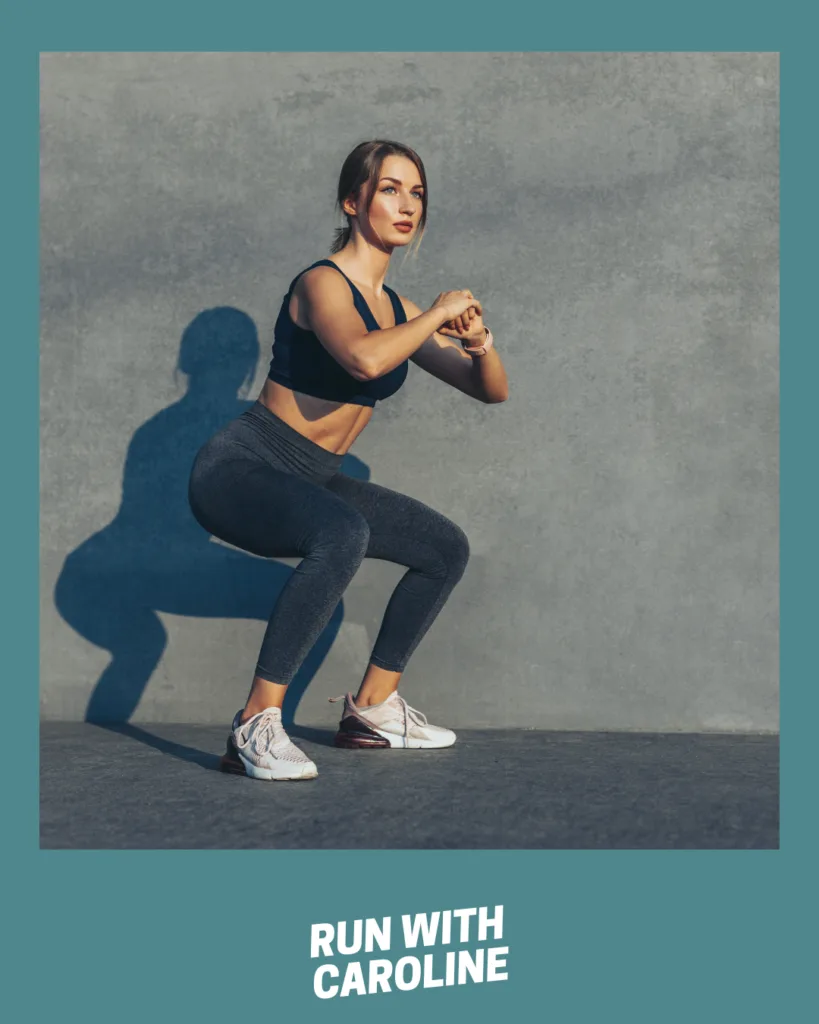
Squats are an efficient way to improve your strength and can be completed in many different ways.
They can be done using your body weight only or by adding a free weight into the mix like a dumbbell, medicine ball or kettlebell.
Many runners suffer from knee injuries such as runner’s knee – squats are great for knee health if done properly.
Like any other exercise, squatting is only beneficial when performed safely and with proper technique.
If you have never squatted before, begin with an air squat.
- Start by extending your arms in front of you.
- Sink your hips down until your thighs are parallel to the floor, making a 90-degree angle. The deeper the better.
- Go ahead and squat until your bum is below parallel.
- When standing back up, do not let your back cave in.
- Keep your knees behind your toes, your weight on your heels and your back straight while you squat.
- If this is too easy for you, go ahead and add a weight. Start small then build your way up.
Jump squats are great to fit in your fitness routine if you’re looking for something a little more intense.
Walking squats are also a good way to mix things up. If you’re feeling adventurous, you can add a box to your workout and jump squat off this.
#2 Deadlift

Deadlifts are beneficial for runners as they help you avoid knee pain and help you to get an upright posture.
Your running form is one of the first things to go during a long race as the fatigue sets in and you slump forward.
Deadlifting will help you avoid that and stay upright, which will give you more endurance.
If you’ve never completed a deadlift before, I’d suggest you seek advice and support from a fitness professional/personal trainer before attempting it yourself.
Deadlifts can be very damaging to your body if you don’t do them properly under correct supervision.
- Stand with your mid-foot under the barbell.
- Bend over and grab the bar with a shoulder-width grip.
- Bend your knees until your shins touch the bar.
- Lift your chest up and straighten your lower back.
- Take a big breath, hold it, and stand up with the weight.
#3 Lunge

The typical lunge targets the quadriceps, hamstrings, and glutes
Building strength and power in these muscles can help you boost sprinting speed as they work together to pull your body in a forward motion.
Lunges are also some of the best leg exercises you can do to improve coordination and balance.
Enhancing your single-leg balance is key for preventing injuries such as ankle sprains.
The basic lunge is what you have to master first before attempting any weighted lunges or variations on the basic lunge.
- Keep your upper body straight, with your shoulders back and relaxed and chin up (pick a point to stare at in front of you so you don’t keep looking down). Always engage your core.
- Step forward with one leg, lowering your hips until both knees are bent at about a 90-degree angle.
- Make sure your front knee is directly above your ankle, not pushed out too far, and make sure your other knee doesn’t touch the floor.
- Keep the weight in your heels as you push back up to the starting position.
Once you’ve mastered the lunge and feel comfortable with it, you can build your way up and add weights.
I love to do walking lunges with weights on either side.
Jump lunges are also great as part of a HIIT workout to really get your heartbeat going and blood pumping.
#4 Push-up

As runners, we associate all our strength with our legs and core, but it’s important to remember that your upper body plays a key role in your running too.
Sometimes it can feel there’s an imbalance between your upper and lower body.
Push-ups are a great way to get your upper body strength back on track.
Push-ups are also some of the best and most efficient exercises you can do to increase strength and endurance in your upper body.
- Start by laying down on all fours with your arms positioned at a slightly wider position than your shoulders.
- On the inhale, bend your elbow and lower your body to the ground. Lower your body until your chest is touching or almost touching the floor.
- On the exhale, push away from the floor until you have fully extended your arms.
- Don’t let your elbows move past your wrists, either out to the side or behind the wrist. Instead, do your best to keep your elbows above your wrists the entire time. The elbows should form a 90-degree angle.
- Don’t slouch or sag.
Walking push-ups are a great variation of the standard push-up and help to build your strength and stamina.
Diamond push-ups are also a good exercise to try once you feel you’ve mastered the standard push-up.
#5 Plank

The plank is a good exercise to help build your core strength.
Core strength is a key component of proper running form. A good core helps you to hold a strong and stable position for longer.
Luckily for us runners, there are a variety of plank exercises to help build the core strength necessary for more efficient running form and fewer overuse injuries.
Planks can be done virtually anywhere and require no equipment. They’re perfect for beginners—and even the fastest of runners.
- Find a solid surface. Lie on your front with your fists clasped, elbows pushed into your sides by your ribs, forearms on the floor and toes tucked under.
- Push your bodyweight up so that it’s resting on your forearms and feet, in a straight line parallel to the floor.
- Squeeze the muscles in your bottom and things and push your heels together while pulling up on your pelvic floor.
- Check your back and bottom aren’t popping up or caving in and that you are making a straight line from heels to head so that your neck is parallel to the floor.
There are lots of variations on the plank that you could try if the basic plank gets a bit too boring.
These include: the push-up plank, side plank, side arm raise in the plank position and push-up plank shuffle.
#6 Hip bridge
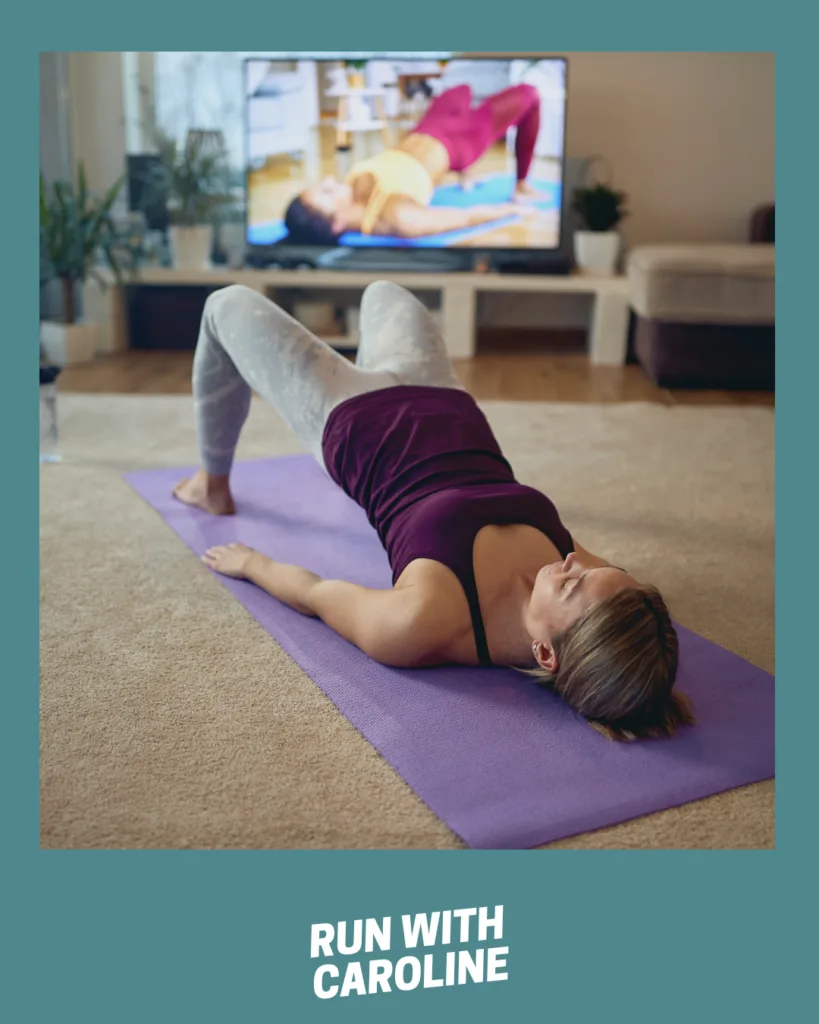
Spending all day sitting behind a desk is a shortcut to weak glutes and lower back problems.
The impulse is often to sit too far forward, which causes your hip flexors to become tight and also results in the glutes effectively switching off.
Activating them as part of your training programme does wonders not only for your physique but for your structural health.
Hip bridges are a good way to facilitate this switch.
- Lie face up on the floor, with your knees bent and feet flat on the ground.
- Keep your arms at your side with your palms down.
- Lift your hips off the ground until your knees, hips and shoulders form a straight line.
- Squeeze those glutes hard and keep your abs drawn in so you don’t overextend your back during the exercise.
- Hold your bridged position for a couple of seconds before easing back down.
You should feel the burn in your glutes and your hamstrings if you’re doing it correctly.
The hip bridge is also great for improving hip mobility and strengthening your lower back, two things that any desk-bound worker can really benefit from.
- 5 things I wish I’d known before returning to running - March 3, 2024
- Running 20 minutes a day: Benefits + how to start - January 27, 2024
- How to run your first 2 hour half marathon - January 16, 2024
